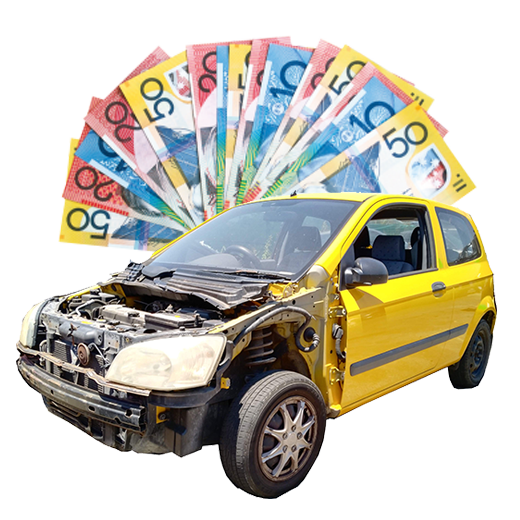Let's get one thing straight from the start: when it comes to getting rid of old motor oil, there are two places it should never go—down the drain or in your regular rubbish bin. The only right way is to collect it properly in a sealed container and take it to an authorised drop-off point, like your local council depot or a participating auto parts shop.
Why You Can't Just Throw Away Used Motor Oil
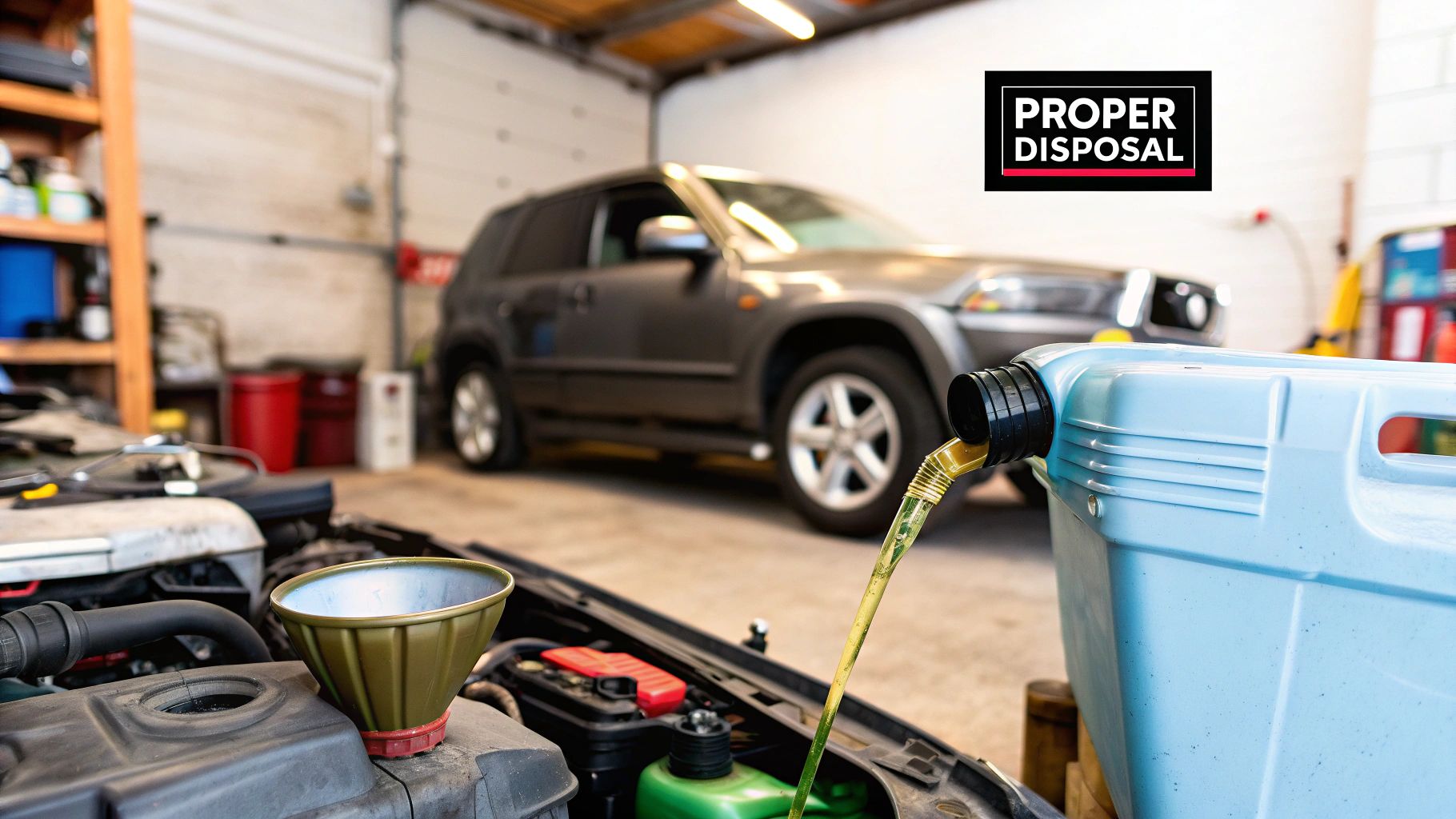
Before we get into the how, it’s really important to understand the why. Tossing out used motor oil isn't just a lazy shortcut; it's a genuine environmental hazard with some pretty serious consequences. That dark, sludgy liquid is more than just dirty—it's loaded with toxic junk it picked up from your engine.
The Hidden Dangers in Used Oil
As motor oil does its job, it collects a nasty mix of heavy metals like lead and arsenic, plus other harmful chemicals. This process turns a simple lubricant into a form of hazardous waste. When that waste gets into the environment, the damage spreads fast.
Think about this: a single litre of oil can contaminate up to one million litres of water. That’s a massive impact from a small amount you might drain from your car on a weekend.
This kind of pollution is a direct threat to Australia’s incredible ecosystems. It can poison the soil, harm native wildlife, and even find its way into our drinking water. This is exactly why the rules around its disposal are so strict. For a deeper dive into the legal side of things, the UK Hazardous Waste Disposal Regulations provide a great example of the strict controls in place.
The bottom line: Used motor oil doesn't just disappear. It sticks around in the environment, causing long-term damage that is incredibly difficult and expensive to fix.
Impacts of Improper Oil Disposal Methods
Here's a quick look at the environmental risks when used motor oil ends up in the wrong place.
| Disposal Method | Primary Environmental Risk | Real-World Consequence |
|---|---|---|
| Pouring Down Drains | Water System Contamination | Ends up in rivers and oceans, harming aquatic life and potentially polluting drinking water supplies. |
| Throwing in Rubbish | Landfill Leakage | Oil can seep from landfills (leachate) into the ground, contaminating soil and groundwater for decades. |
| Dumping on the Ground | Soil & Plant Contamination | Kills plants, poisons the soil, and can be washed by rain into nearby streams and waterways. |
As you can see, there’s no "safe" way to just dump it. Proper recycling is the only responsible option.
Connecting Your Actions to the Bigger Picture
Every time you do a DIY oil change, you have a chance to be a part of the solution. The simple act of recycling your used oil stops pollution in its tracks and helps conserve a valuable, non-renewable resource.
This mindset applies to bigger items, too. For instance, knowing https://autoremovaladelaide.com.au/how-to-dispose-of-cars/ properly is just as vital for keeping our environment healthy. It's a small effort on your part that creates a huge positive ripple effect.
How to Safely Collect and Store Used Oil
Handling used oil correctly starts the second it drains from your engine. Getting this first part right is the key to preventing a nasty spill and making sure the oil can actually be recycled.
Your best friend for this job is a decent drain pan. I’ve found the ones with a really wide mouth are great for catching that initial gush, and high sides are a must to stop splashes from getting all over your driveway. Look for one with a built-in spout, too—it makes pouring the oil into a storage container so much easier and cleaner.
Choosing the Right Storage Container
Once you've drained the oil, you need a safe place to put it. This is where a lot of people go wrong. Don’t just reach for an old milk jug or a soft drink bottle. They’re far too flimsy and the plastic can actually break down from the oil, leading to leaks. Plus, their caps just aren't designed to create a proper seal.
You’ve got a couple of much better options:
- The Original Bottle: The easiest (and cheapest) solution is to carefully pour the used oil back into the bottle the new oil came in. It's purpose-built to hold oil and has a screw-on cap you know will seal tightly.
- A Dedicated Container: If you do a lot of oil changes, it might be worth buying a container specifically made for used oil from an auto parts shop. They're built tough, seal up properly, and are usually designed to make pouring mess-free.
These practices are crucial for any home mechanic, but they're absolutely essential when managing waste in an automotive workshop where oil changes are a daily task.
A simple but critical final step: grab a marker and clearly label the container ‘Used Motor Oil’. It stops any confusion later on and tells the recycling centre exactly what’s inside.
The infographic below really drives home what can happen when used oil isn't handled with care.
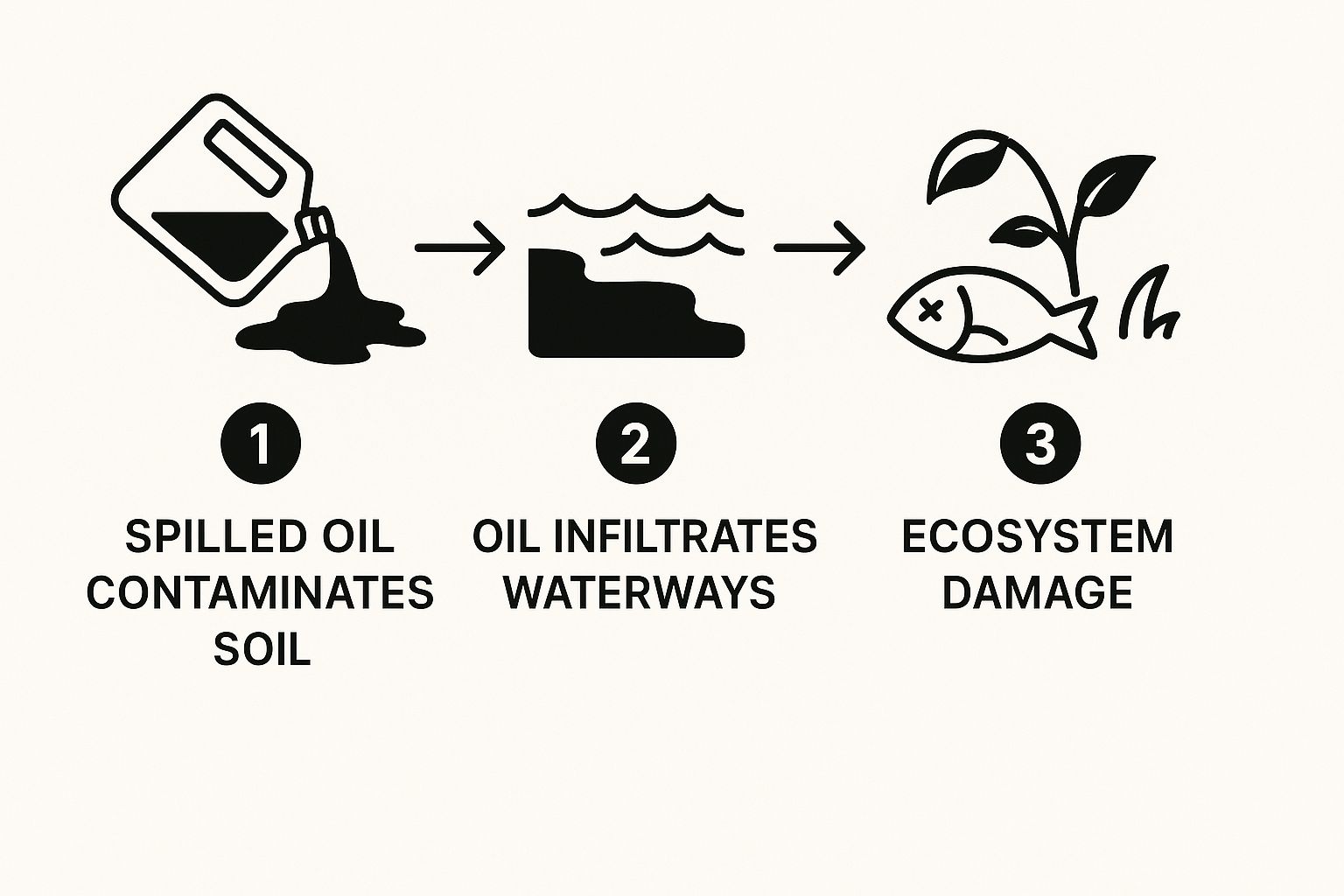
As you can see, one small mistake can quickly spiral from a bit of contaminated soil into a much bigger problem for our waterways.
Once it's sealed and labelled, just find a cool, dry spot to store the container. Keep it upright and safely out of reach of kids and pets until you're ready to take it for recycling.
Finding Your Nearest Used Oil Collection Point
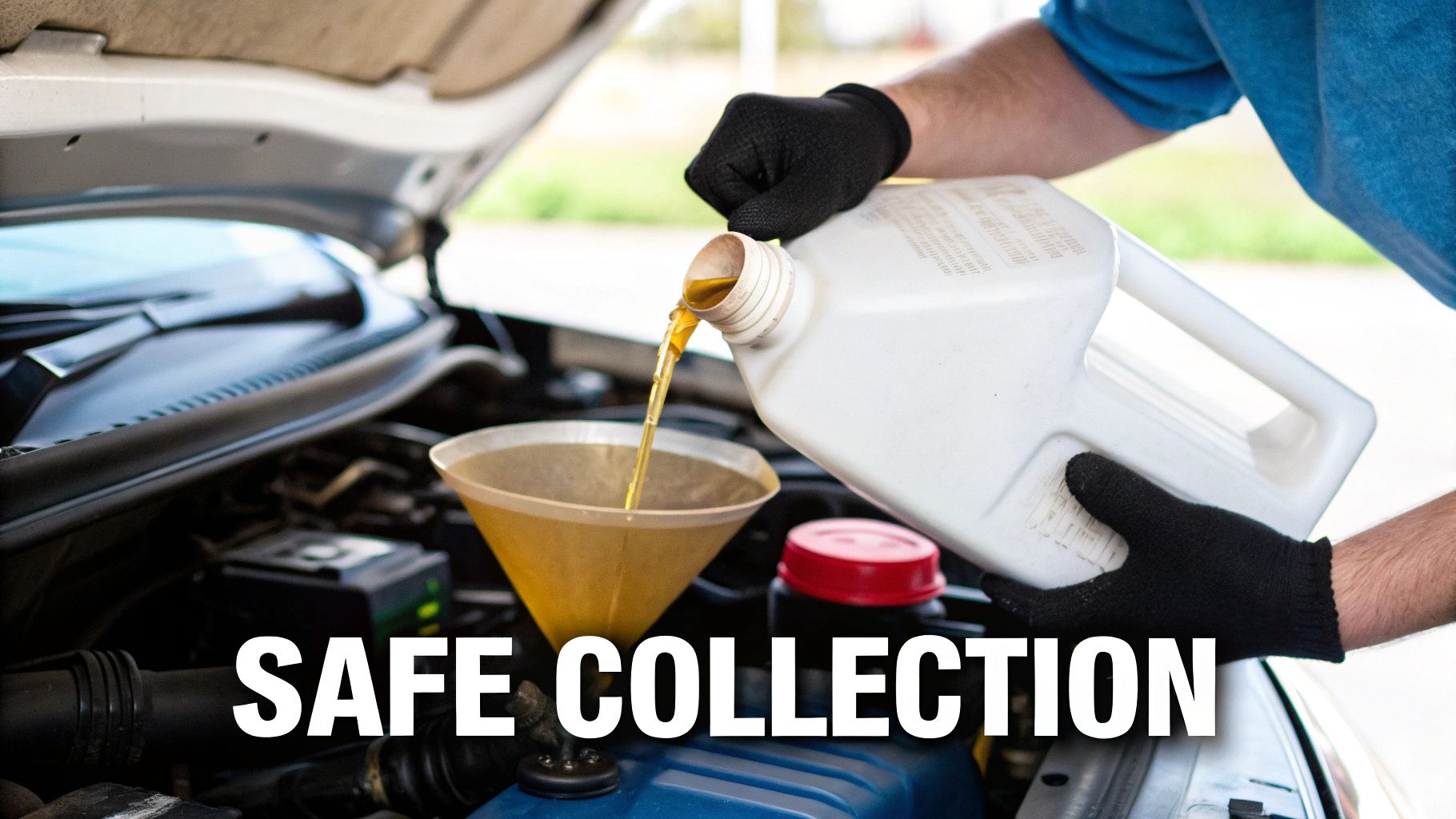
Alright, you've got your used oil safely bottled up and ready to go. The final piece of the puzzle is figuring out where to take it. The great news is that Australia has a solid network of collection points, so you're never too far from a proper disposal spot.
You’ve got a few different options, and for household amounts, it’s usually free. These places are set up to handle materials like used oil, making sure it gets recycled correctly instead of causing environmental headaches.
Common Drop-Off Locations in Australia
Your first port of call should usually be your local council. Most council-run waste depots or transfer stations have designated tanks specifically for used motor oil. It’s a straightforward and reliable option.
But that's not your only choice. Many big auto retailers have also gotten on board, which can be incredibly convenient.
- Auto Parts Stores: Chains like Supercheap Auto and Repco often have a collection tank. It’s a brilliant service—you can drop off your old oil when you pop in to buy new filters or parts.
- Participating Workshops: Some local mechanics and service centres will also take used oil off your hands. It's always worth a quick phone call to your trusted garage to see if they're part of the program.
The easiest way to find what's near you is to jump online. A tool like RecyclingNearYou lets you punch in your postcode and instantly pulls up a map of authorised facilities. For more general information, our guide on finding automotive recycling near me can also help get you started.
Pro Tip: I always recommend calling ahead before you head out. It’s a simple step that saves a lot of grief. You can confirm their opening hours, make sure their tank isn't full, and double-check any specific rules they might have.
Important Details to Check Before You Go
A quick call can also clarify a few key details. Most public drop-off sites will take up to 20 litres of used oil per person at no charge, but it’s always best to confirm that limit just in case.
While you're on the phone, ask if they take related waste too. Many facilities that accept oil will also take your old, gunked-up oil filters and even the empty plastic containers. Since these can't go in your kerbside bin, it’s a great way to handle the entire oil change cleanly and responsibly.
It’s a collective effort that really matters. Australians generate over 14 million litres of waste oil every year, and making sure it all gets collected properly is a huge task.
What Happens to Oil After You Drop It Off
So, you've sealed up your container of old engine oil and dropped it off. Job done, right? Well, that's your part sorted, but have you ever wondered what happens next? That sludgy, black liquid is about to go on a pretty impressive journey, transforming from hazardous waste back into a valuable product.
Many people assume used motor oil just gets burned off as a low-grade industrial fuel. While some of it does go that way, the real win is when it's sent for re-refining. This isn't just a simple filtering process; it's a highly sophisticated system that gives the old oil a second life.
The Re-refining Journey
Once the oil arrives at a specialised recycling plant, the first job is to get rid of the major contaminants. Water is separated out, and a series of filters pull out all the solids—think dirt, grit, and tiny metal filings worn from your engine.
After that initial clean-up, the oil goes through a process that’s surprisingly similar to refining crude oil from the ground up. Using techniques like vacuum distillation and hydro-treating, all the spent additives, chemical impurities, and other gunk are stripped away. What you're left with is a clean, high-quality base oil, which is the main ingredient for brand-new lubricants.
In fact, this re-refined base oil is often so pure it’s practically indistinguishable from "virgin" base oil. All it needs is a fresh package of additives, and it’s ready to become the high-performance engine oil you'd buy right off the shelf.
This is a fantastic example of a circular economy in action. The Australian automotive oil recycling market is a big part of this, and the numbers are impressive. Recycling used motor oil can save up to 90% of the energy it would take to produce the same oil from crude. If you're curious about the industry's scale, you can explore detailed market reports on waste oil recycling to see the full picture.
By taking those few minutes to recycle your used oil, you’re doing more than just keeping it out of our waterways. You're helping conserve natural resources, slashing energy consumption, and lowering the country's carbon footprint. It really puts into perspective the importance of not just proper disposal, but all forms of recycling automotive parts.
What Not To Do With Your Used Motor Oil
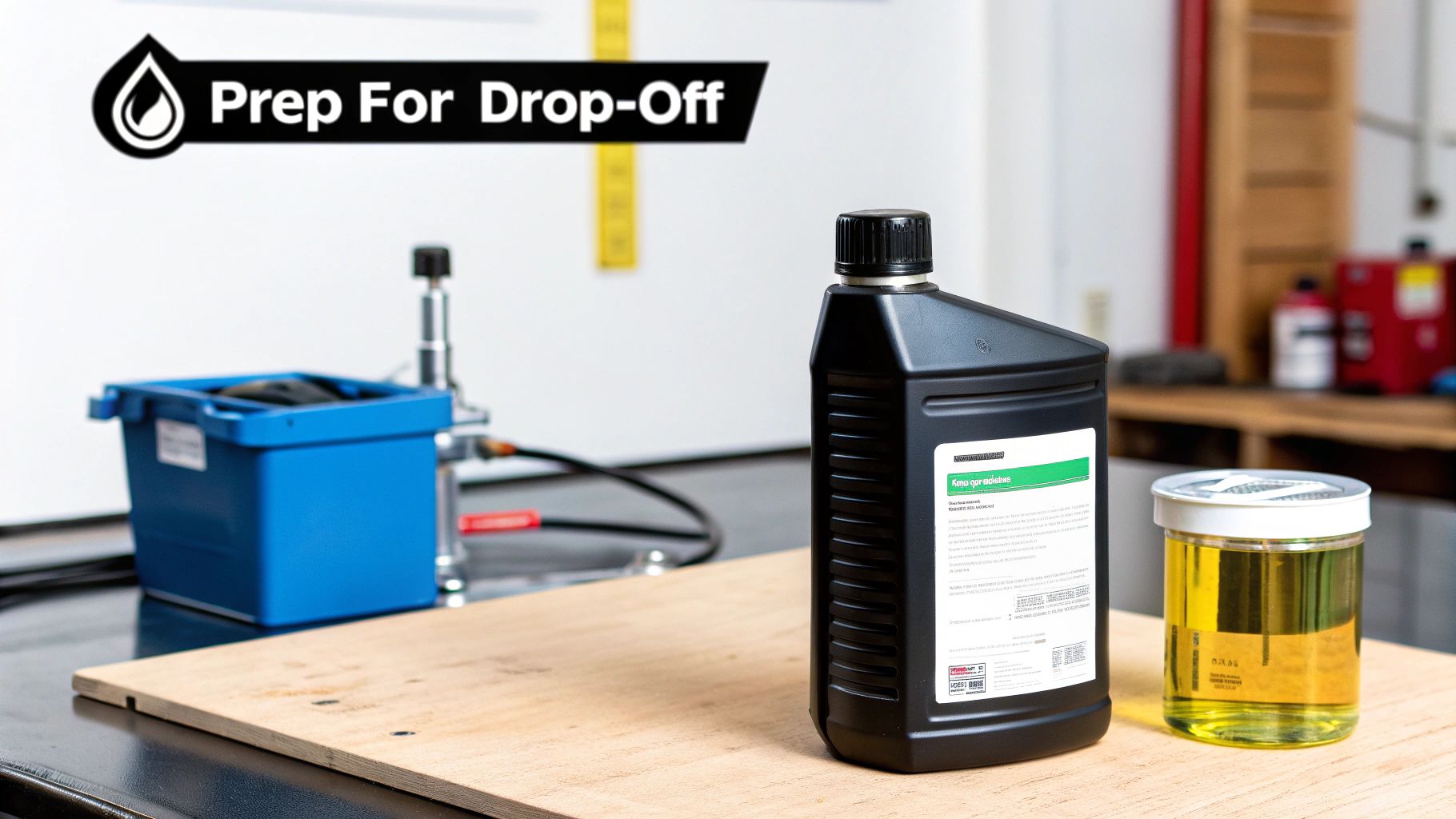
Getting oil disposal right is half the battle; the other half is knowing what not to do. I've seen it all over the years—well-intentioned folks who accidentally make their used oil unrecyclable with one simple slip-up. It's frustrating for them and for the recycling depot.
The most common culprit? Mixing fluids. It’s tempting to just pour that last bit of coolant or brake fluid into your oil drum to get rid of it, but that's a game-ender. Recycling facilities are incredibly strict about purity, and even a small amount of another chemical can contaminate the entire batch. When that happens, they often have to reject the whole lot.
Another easy mistake happens in the car. Just chucking the container on the back seat or in the boot without tying it down is a recipe for disaster. One hard brake is all it takes to send oil sloshing all over your upholstery—a smelly, expensive mess you really don't want to deal with.
The Big Disposal Don'ts
To make sure your trip to the recycling centre is a success, here are a few critical things to steer clear of.
-
Don't grab just any old container. Flimsy milk jugs or soft drink bottles can easily split or leak. Stick with the original oil bottle or, even better, a dedicated, sturdy container with a screw-top lid.
-
Never, ever pour it down a drain. It’s not just a bad idea; it’s illegal and a real environmental nightmare. Just one litre of oil can contaminate up to 1 million litres of water.
-
Don’t just chuck it in your household rubbish. Hiding it in the bin means it ends up in a landfill, where it can slowly seep into the soil and groundwater for years to come.
The golden rule is simple: keep your used oil pure. Don’t let anything else get in there. This is the only way to ensure it can be properly re-refined, which is the whole point of recycling it in the first place.
By sidestepping these common blunders, you’re not just getting rid of waste; you're making a genuinely positive contribution to Australia’s recycling efforts.
Got Questions About Oil Disposal? We've Got Answers
Even with a solid plan, a few questions often pop up when you're dealing with used motor oil for the first time. Let's run through some of the most common queries we hear from DIY mechanics and car enthusiasts across Australia.
Getting these details right makes the whole process smoother and ensures you’re doing the right thing for the environment.
Can I Just Toss Empty Oil Bottles in My Recycling Bin?
That’s a common mistake, but the short answer is no. Even when a plastic oil container seems completely empty, there’s always a film of residual oil coating the inside. This residue is enough to classify the bottle as hazardous waste.
Because of this contamination, your local council almost certainly won't accept them in the standard kerbside recycling bin.
The fix is easy, though. The same place you take your used oil will usually have a designated spot for the empty containers. Just ask the staff when you get there—they'll point you in the right direction.
What’s the Best Way to Clean Up an Oil Spill on My Driveway?
Spills happen to the best of us. The most important thing is to act quickly before the oil has a chance to soak in or get washed into the stormwater system. Whatever you do, don't reach for the hose! Hosing it down just sends that pollution straight into our local creeks and waterways.
Instead, here’s what you do:
- Stop the spread. First, contain the spill so it doesn’t get any bigger.
- Soak it up. Grab something absorbent and cover the entire spill. Kitty litter is perfect for this, but sand or even sawdust will do the trick in a pinch.
- Bag it up. Let the absorbent material sit for a bit to soak up as much oil as possible, then sweep the whole lot into a bag or container and seal it up.
This mixture is now contaminated waste, so it can’t go into your regular rubbish bin. Give your local council a call and they’ll tell you where to dispose of it safely.
A quick clean-up can stop a small accident in your driveway from becoming a serious environmental headache for the local ecosystem.
Does It Cost Anything to Recycle Used Motor Oil?
For everyday folks like us, it’s almost always free. Australia has a great system where a small levy on all new oil sold goes towards funding the collection and recycling of the used stuff. It’s all designed to make sure everyone does the right thing.
Most collection facilities will happily take up to 20 litres from you at no charge. Keep in mind this is for household quantities only. Commercial workshops and businesses have to pay for specialised waste services to handle their much larger volumes.
If you're dealing with old car fluids because you're finally getting rid of a clunker, let Auto Removal Adelaide make it easy. We take care of everything, from free car removal to paying you instant cash for your old, scrap, or broken-down car. Find out what your car could be worth at https://autoremovaladelaide.com.au.

